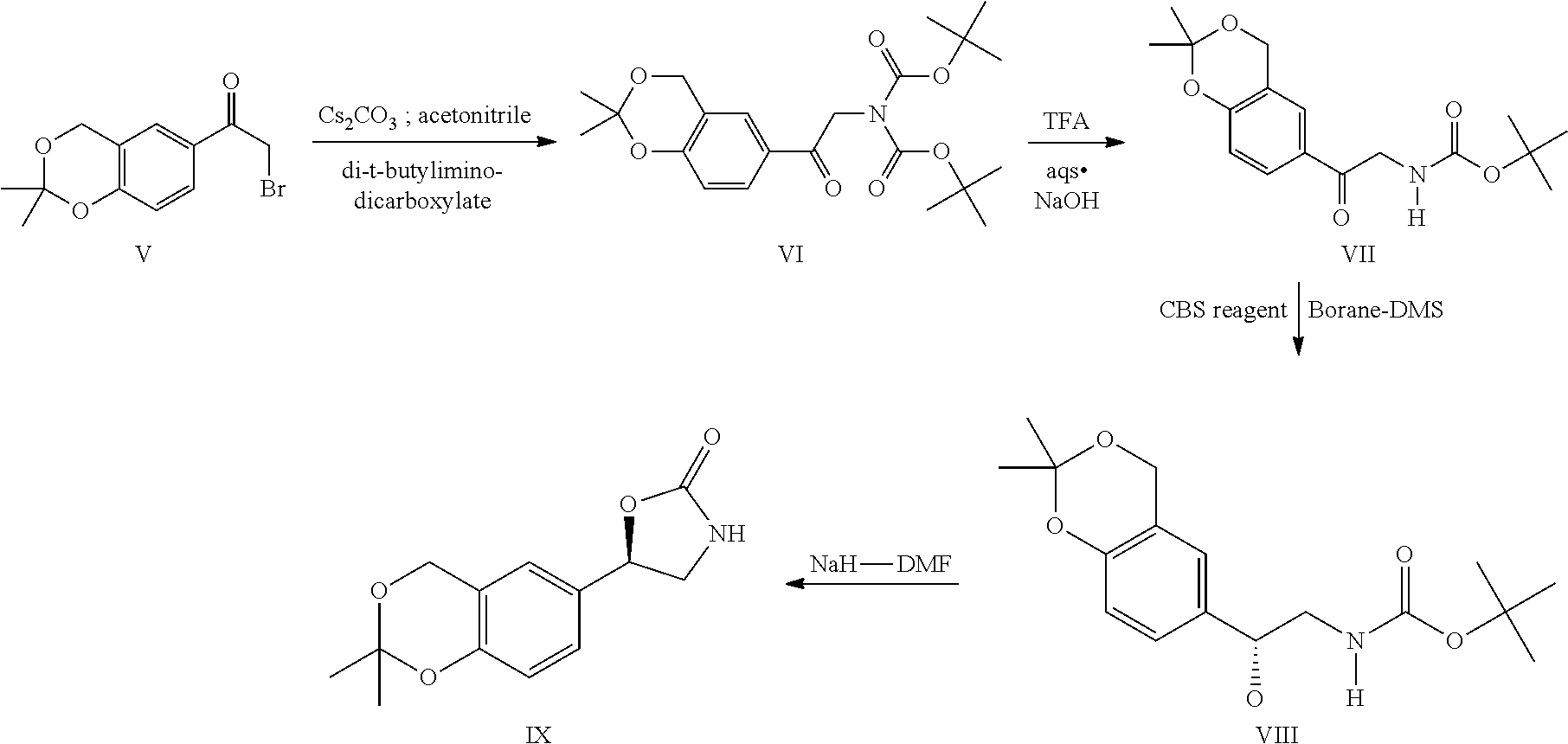Process for the preparation of vilanterol and intermediates thereof
a technology of vilanterol and intermediates, which is applied in the preparation of ethers, drug compositions, carboxylic compound preparations, etc., can solve the problems of inability to use column chromatography procedures on the commercial scale, inability to form the corresponding ether impurities, and tedious practice, so as to achieve the effect of increasing yield and purity
- Summary
- Abstract
- Description
- Claims
- Application Information
AI Technical Summary
Benefits of technology
Problems solved by technology
Method used
Image
Examples
example 1
Preparation of 6-bromo-2,2-dimethyl-4H-1,3-benzodioxine (III)
[0121]5-bromo-2-hydroxy benzyl alcohol (1.0 eqt), acetone (6V) and THF (4V) were charged together at 25-30° C. under nitrogen. The reaction mass was cooled to 0-5° C. AlCl3 (0.35eqt) was added slowly in portions to the reaction mass at 0-5° C. The reaction mass was raised to 25-30° C. and allowed to stir over a period of 1 hr. After completion of the reaction the temperature of the reaction mass lowered to 0-5° C. and quenched with 10% NaOH solution. The compound was extracted into toluene and further evaporated under vacuum below 60° C. to obtain the desired compound as brown color liquid.
[0122]Yield: 92%; purity by HPLC: 99.43%
example 2
Preparation of 1-(2,2-dimethyl-4H-1,3-benzodioxin-6-yl) ethanone (IV)
[0123]Compound III (1.0eqt) was dissolved in THF (10V) at 25-30° C. and was cooled to −70 to −75° C. n-Butyl lithium (1.5 eqt) was added slowly the above reaction mass at the set temperature and stirred over a period of 60 min. N-methoxy-N-methylacetamide (1.5eqt) in THF (1V) was added to the above reaction mass at −70 to −75° C. The reaction mixture was further allowed for completion. After the completion of reaction, the temperature was raised to −30 to −20° C. and treated with 1N HCl. The reaction mass was further raised to 20-25° C. and ethyl acetate was added. The organic fractions were collected and treated with water. The combined organic fractions were dried over sodium sulfate and concentrated under vacuum to obtain the compound. This was then co distilled with heptane (5V). The crude compound was slurried with diisopropylether-heptane (1:3) at 0-10° C. The resultant was filtered and washed with heptane an...
example 3
Preparation of 2-bromo-1-(2,2-dimethyl-4H-1,3-benzodioxin-6-yl)ethanone (V)
[0125]Compound IV (1.0 eqt) was dissolved in THF (30V) at RT and the temperature of the reaction mass lowered to −70 to −75° C. Sodium bis(trimethylsilyl)amide (1M in THF; 1.1 eqt) was added slowly to the above reaction mass and allowed to stir over a period of one hour. TMSCl (1.05eqt) was added to the above reaction mass slowly. A solution of bromine (1.8 eqt) was added to the above and the reaction maintained at −70 to −75° C. After the completion of the reaction, the reaction mass temperature was raised to −25° C. and MTBE was added. The reaction mass was quenched with 5% sodium sulphite solution and the organic fractions were collected and treated with brine. The organic fraction was separated and dried over sodium sulfate and washed with MTBE. The MTBE fraction was evaporated under vacuum at 40-45° C. The crude product was azeotroped with heptane followed by heptane washings followed by filtration and d...
PUM
| Property | Measurement | Unit |
|---|---|---|
| chiral purity | aaaaa | aaaaa |
| temperature | aaaaa | aaaaa |
| temperature | aaaaa | aaaaa |
Abstract
Description
Claims
Application Information
 Login to View More
Login to View More - R&D
- Intellectual Property
- Life Sciences
- Materials
- Tech Scout
- Unparalleled Data Quality
- Higher Quality Content
- 60% Fewer Hallucinations
Browse by: Latest US Patents, China's latest patents, Technical Efficacy Thesaurus, Application Domain, Technology Topic, Popular Technical Reports.
© 2025 PatSnap. All rights reserved.Legal|Privacy policy|Modern Slavery Act Transparency Statement|Sitemap|About US| Contact US: help@patsnap.com



